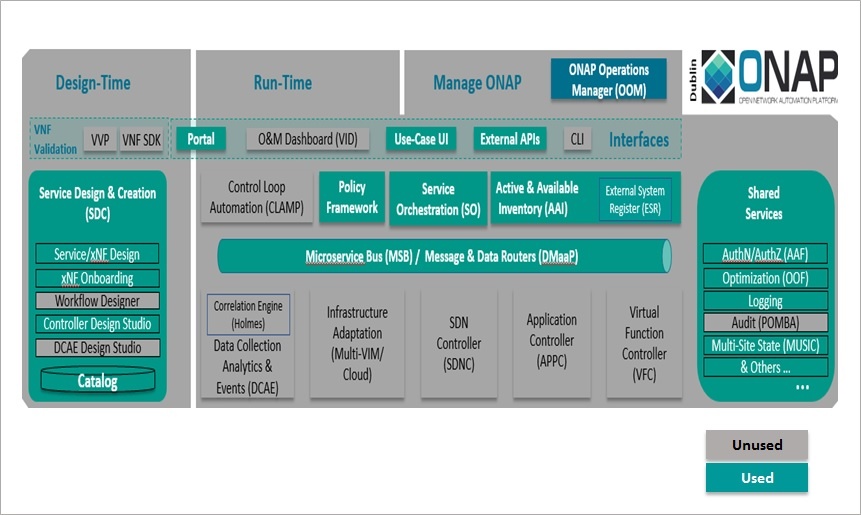
If you already have the Full ONAP(Frankfurt Release) environment, You can use it for 5G network slicing experience.
To reduce the resource requirements of ONAP ,you can install a minmum scope ONAP to test the 5G Network scling.
17/32 modules are used in 5G network slicing usecase(refer to oom repo: kubernetes/onap/resources/overrides/onap-5g-network-slicing.yaml). and some charts of some modules are not used.

Please find the details:
| Module | Contained in the customization version(Yes/No) | removed charts(Which is not used in the module) | Description |
|---|---|---|---|
| aaf | Yes | ||
| aai | Yes | Required image version: aai-traversal:1.6.3、aai-schema-service:1.6.8、aai-graphadmin:1.6.3 | |
| appc | No | ||
| cassandra | Yes | ||
| cds | Yes | cds-command-cexecuter | |
| clamp | No | ||
| cli | No | ||
| consul | No | ||
| contrib | No | ||
| dmaap | Yes | ||
| dcaegen2 | No | ||
| pnda | No | ||
| esr | Yes | ||
| log | Yes | ||
| sniro-smulator | No | ||
| oof | Yes | Required image version: optf-osdf:2.0.4、optf-has:2.0.4 | |
| mariadb-galera | Yes | ||
| msb | Yes | ||
| multicloud | No | ||
| nbi | Yes | Required image version: 6.0.3 | |
| policy | Yes | Required image version: policy-pe:1.6.4 | |
| pomba | No | ||
| portal | Yes | ||
| robot | Yes | ||
| sdc | Yes | sdc-dcae-be;sdc-dcae-fe;sdc-dcae-dt;sdc-dcae-tosca-lab;sdc-wfd-be;sdc-wfd-fe | |
| sdnc | No | ||
| so | Yes | so-openstack-adapter;so-sdnc-adapter;so-vfc-adapter;so-vnfm-adapter;so-ve-vnfm-adapter | Required image version: 1.6.3 |
| uui | Yes | Required image version: 3.0.4 | |
| vfc | No | ||
| vid | No | ||
| vnfsdk | No | ||
| Modeling | No |
Request resources:
| Option | CPU | Memory |
|---|---|---|
| Full ONAP | 112 | 224G |
| Customization Version | 64 | 128G |
The following is the recommended component version.
| Software | Version |
|---|---|
| Kubernetes | 1.13.5 |
| Helm | 2.12.3 |
| kubectl | 1.13.5 |
| Docker | 18.09.5 |
Please refer to the following link for the 1-3 steps:
https://docs.onap.org/en/elalto/submodules/oom.git/docs/oom_setup_kubernetes_rancher.html
1.Install kubectl
2.Instal helm
3.Set up NFS
4.Clone the OOM repository from ONAP gerrit:
> git clone http://gerrit.onap.org/r/oom --recurse -submodules
5.Install Helm Plugins required to deploy ONAP:
> cd oom/kubernetes
> sudo cp -R ./helm/plugins/ ~/.helm
6.Currently OOM does not support the chart config , So remove the charts manually. Will work with OOM team to make the chart level configable.
Customize the helm charts to suit use case(from the kubernetes directory):
> rm -rf cds/charts/cds-command-executor/
> rm -rf sdc/charts/sdc-dcae-be/
> rm -rf sdc/charts/sdc-dcae-dt/
> rm -rf sdc/charts/sdc-dcae-fe/
> rm -rf sdc/charts/sdc-dcae-tosca-lab/
> rm -rf sdc/charts/sdc-wfd-be/
> rm -rf sdc/charts/sdc-wfd-fe/
> rm -rf so/charts/so-openstack-adapter/
> rm -rf so/charts/so-sdnc-adapter/
> rm -rf so/charts/so-vfc-adapter/
> rm -rf so/charts/so-vnfm-adapter/
> rm -rf so/charts/so-ve-vnfm-adapter/
7.To setup a local Helm server to server up the ONAP charts:
> helm serve &
| Note the port number that is listed and use it in the Helm repo add as follows: 其它宏 |
> helm repo add local http://127.0.0.1:8879
8.Build a local Helm repository(from the kubernetes directory):
> make all &
9.To deploy ONAP applications use this command:
> helm deploy dev local/onap --namespace onap -f onap/resources/overrides/onap-5g-network-slicing.yaml -f onap/resources/environments/public-cloud.yaml --set global.masterPassword=onap --verbose --timeout 2000 &
10.Check the pod status after install:
> kubectl get pods -n onap
11.Health check:
> bash oom/kubernetes/robot/ete-k8s.sh onap health